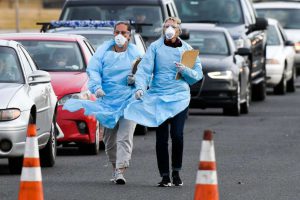MAY 28, 2020

Healthcare workers from the Colorado Department of Public Health and Environment check in with people waiting to be tested for COVID-19 at the state’s first drive-up testing center. – Michael Ciaglo/Getty Images
Federal and state officials across the country have altered or hidden public health data crucial to tracking the coronavirus’ spread, hindering the ability to detect a surge of infections as President Donald Trump pushes the nation to reopen rapidly.
In at least a dozen states, health departments have inflated testing numbers or deflated death tallies by changing criteria for who counts as a coronavirus victim and what counts as a coronavirus test, according to reporting from POLITICO, other news outlets and the states’ own admissions. Some states have shifted the metrics for a “safe” reopening; Arizona sought to clamp down on bad news at one point by simply shuttering its pandemic modeling. About a third of the states aren’t even reporting hospital admission data — a big red flag for the resurgence of the virus.
The spotty data flow is particularly worrisome to public health officials trying to help Americans make decisions about safely venturing out. The lack of accurate and consistent Covid-19 data, coupled with the fact that the White House no longer has regular briefings where officials reinforce the need for ongoing social distancing, makes that task even harder.
New examples seem to sprout up daily. The District of Columbia this week became the latest jurisdiction to endure scrutiny, with the city using a “community spread” metric — excluding nursing homes, correctional facilities and others — as a justification for reopening the area.
Iowa Gov. Kim Reynolds told reporters that the state will share information about outbreaks at meatpacking plants only upon request. And Georgia has only just begun to differentiate between the two types of coronavirus tests it’s been adding into its testing totals for weeks.
“All these stories about undercounts, overcounts, miscounts, are undermining our ability to deal with the pandemic,” said Irwin Redlener, a public health expert at Columbia University. The country, he said, is confronting an “unheard of level of chaos in the data, the protocols, the information.”
The problems are widespread and have infiltrated federal health agencies as well. The Centers for Disease Control and Prevention blended diagnostic and antibody tests, boosting the nation’s overall testing numbers.
The Department of Health and Human Services took out of context data on the danger of “deaths of despair” from overdoses and suicides amid an economic debacle, according to the authors of the report in question. On Tuesday, an ethics center at Harvard rebuked the White House for misleadingly citing numbers from one of its studies to buttress the administration’s national testing report.
Nearly half the U.S., meanwhile, has registered rising caseloads as states press ahead with reopening the economy. While some of that reflects increased testing, an accompanying uptick in hospitalizations is worrying experts, including former FDA commissioner Scott Gottlieb.
The White House, which has insisted it’s following a “data-driven path” to reopening, did not respond to questions about the data that it’s relying on.
But within the Trump administration, some officials aren’t merely ignoring the warning signs. They’re also selectively using scientific advice and models in their quest for a swift reopening. For instance, HHS Secretary Alex Azar warned during a recent Cabinet meeting that the U.S. could see 65,000 additional “deaths of despair” if the country does not get back on track to normalcy soon.
In reality, the study he cited explicitly warned against lifting lockdowns before health data showed it was safe to do so.
“Some might use this report to argue that this is why our economy needs to open up fast. But that’s NOT what we are saying,” wrote the authors of the report, which was published by the American Academy of Family Physicians and Well Being Trust. “Even as of today parts of the country are opening, data suggest that this is premature due to a lack of consistent testing, which allows public health authorities to trace, treat and isolate to prevent further spread.”

Times Square billboards go dark for one minute in a message to all the most vulnerable businesses, like restaurants and hospitality businesses which need more support to survive the coronavirus pandemic as seen on May 27 in New York City.
Harvard University’s Safra Center for Ethics similarly publicly chastised the administration. HHS used one of the center’s testing models to suggest the U.S. was already testing enough people to contain the virus — when the center was arguing that testing is woefully inadequate to ensure a safe reemergence from “stay at home.”
“The Department’s report does not provide an accurate summary of the modeling supporting our recommendations,” said the center’s director, adding that HHS had cited a “nonprimary” model in the study’s appendix and then adjusted the assumptions underpinning it.
The data challenges are making it even harder for the states to balance health and economic imperatives. In addition to pulling back from its historic role as the central health authority during public health crises, the Centers for Disease Control and Prevention has established few firm standards for how states should monitor Covid-19 and made little overt effort to coordinate its messaging with state and local health departments.
That’s created a patchwork system where key health information is collected and communicated with little uniformity, and amid rising concern over whether Americans are receiving reliable reports about the pandemic fight.
At least a half-dozen states have admitted to inflating their testing figures by mixing two different types of tests into its totals, a practice widely derided as scientifically unsound.
In Georgia, where Gov. Brian Kemp has been among the strongest proponents of reopening, the inclusion of antibody tests inflated the state’s overall testing count by nearly 78,000 — a disclosure that came a few weeks after officials posted a chart of new confirmed cases in Georgia with the dates jumbled out of order, showing a downward trajectory.
Like several other states, Georgia’s health department began listing separate totals for its antibody and diagnostic test counts only after reporters discovered it had been quietly combining the two.
Georgia’s count of hospitalized coronavirus patients also includes only those who were already in the hospital when their diagnosis was reported to the state, a limitation that the state has openly admitted likely creates “an underestimation of actual hospitalizations.”
“It’s going through political filters there in the same way that maybe we’re seeing some information go through political filters at the federal level,” said Harry Heiman, a professor at Georgia State University’s School of Public Health, of the state’s coronavirus data. “It makes it really hard to know what’s going on.”
Florida has weathered a string of controversies over its evidence to support GOP Gov. Ron DeSantis’ boasts that the state is faring better than most, including an attempt to block access to information on nursing home deaths and the firing of a health department official who now alleges she was pushed out for refusing to manipulate the state’s data.
A separate dispute involved the health department’s attempt to suppress the coronavirus death count published by Florida’s medical examiners — a figure that was initially higher than health officials’ tally.
“Never, before today, has the Department of Health raised an eyebrow that this information is confidential and privileged,” said Stephen Nelson, the district medical examiner for Polk County, Fla.
By the time the examiners’ death toll was finally released almost two weeks later amid public pressure, the number was lower than the one published by the health department.
States led by Democratic governors haven’t been immune from transparency questions either. New Jersey revised down its nursing home coronavirus death count by about 1,400 after concluding it would only count those with a lab-confirmed diagnosis of the disease, a move a GOP state legislator called a “whitewash.”
And Illinois briefly drew fire after it limited its public reporting on nursing home cases and deaths to only those with “active” outbreaks — a decision that the state quickly reversed.
Nursing homes have been particularly weak on transparency, with state leaders trying to give the appearance of a blunted impact for older Americans.
“Political leaders would like to trim their numbers, and a convenient way to do that is to count only those deaths that are proven by testing to involved Covid-19,” said Joanne Lynn, a former geriatrician and current analyst at Altarum. Some officials within the Trump administration have embraced this approach amid skepticism over the rising national death toll.
Data suppression in nursing homes is a particularly hard blow in a sector that has historically struggled for transparency. In a Senate Aging Committee hearing last week, one expert noted: “Right now, [patients and caregivers] can’t easily find which ones have Covid outbreaks. We need to give them that information so they can make good decisions.”
Those abrupt alterations make it more difficult to track the progression of the virus as the pandemic response fragments — and to hold political leaders accountable for their decisions.
“I have never seen politicians come in like this and question the science,” said Melissa Marx, a public health professor at Johns Hopkins University and former CDC official. “In my mind, it’s unprecedented.”
Yet unlike in past public health emergencies, the Trump administration has signaled little interest in overseeing how states combat the pandemic in this next phase, and what evidence they rely on to do it.
In response to questions about states manipulating and altering their coronavirus data, an HHS spokesperson told POLITICO that “state leaders have the clearest insights into the situation on the ground in their states, and we stand ready to provide support as states begin to reopen safely.”
As for the CDC, the vaunted public health agency spent the past week under fire for its own data issues, after confirming it, too, was combining different types of tests in calculating the nation’s testing totals. The CDC, which blamed the lapse on combined testing numbers reported by individual states, said it will break out figures for the different tests “in the coming weeks.”
It’s an environment that threatens to erode public trust, experts warn. “You want people to trust what authorities are telling them,” said Jennifer Kates of the Kaiser Family Foundation, and that trust is going to be difficult to earn.
Courtesy/Source: Politico










































































































